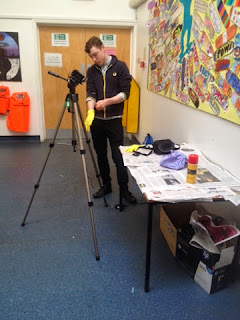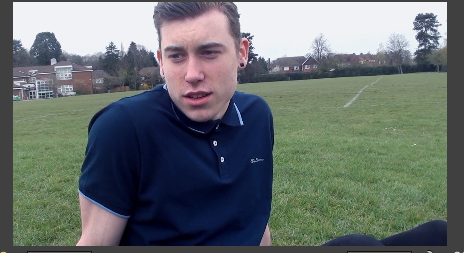AS Media Studies
Friday, 25 April 2014
Sunday, 20 April 2014
Thrillers: Sub-genres
Romantic Thrillers
Hitchcock's 1958 direction of "Vertigo" is exemplary in manifesting the key themes and ideologies that constitute a romantic thriller - although "Vertigo" is sometimes regarded as more of a psychological thriller, it can be credited as a romance influenced thriller. Romance thrillers work very well in terms of suspense as it presents a 'will they/won't they' question.
Political Thrillers
Political thrillers thrive on the notion of a group of people (syndicate) fighting against another group of people trying to establish an equillibrium. It assumes that a specific group of people (most commonly weaker) are fighting against a more powerful group of people advocating evil policies through totalitarianism.
Hitchcock's 1958 direction of "Vertigo" is exemplary in manifesting the key themes and ideologies that constitute a romantic thriller - although "Vertigo" is sometimes regarded as more of a psychological thriller, it can be credited as a romance influenced thriller. Romance thrillers work very well in terms of suspense as it presents a 'will they/won't they' question.
Political Thrillers
Political thrillers thrive on the notion of a group of people (syndicate) fighting against another group of people trying to establish an equillibrium. It assumes that a specific group of people (most commonly weaker) are fighting against a more powerful group of people advocating evil policies through totalitarianism.
Evalutation
Overall, we produced a comprehensive and relevant thriller film that adhered to the codes and conventions of contemporary thriller films. We ensured that the editing involved making our lighting very dark through the use of colour correction and contrast. We realised that in order to priduce a successful thriller meaning had to be built through the Mise en Scene. Another essential in thrillers is the use of non-diegetic sounds - we used these to our advantage and used resources that provided non copyrighted horror sounds. These were prolonged noises that culminated in sharp, intense sounds. These sounds were inspired by Hitchcock's Psycho. In terms of our camera work, at times we were sloppy: we sometimes cut segments of peoples head out of the frame of the shot (although our opening scene requires the antagonist's identity to remain concealed). This is something we would change if we were to shoot our opening again. We would also have liked to obtain an image/some footage of a full moon to use as a graphic match to Daisy's necklace. This would have meant we could include more complex editing processes in our feature.
Saturday, 12 April 2014
Research: What makes a thriller and famous examples (Analysis of "Se7en" opening)
Thrillers are said to elicit excitement, and an intense adrenaline rush that creates a compelling atmosphere that has the audience demanding to know more. Famous examples of thrillers (in terms of contemporary conventions) Silence of the Lambs (1991), Se7en (1995) and The Mechanist (2004). As alluded to previously, the conventions of genre are forever changing, meaning films are subject to change classification due to the conventions being altered on a regular basis. For example, if Silence of the Lambs had been released in 1960, it would unquestionably been branded a horror, due to the content that was being produced at that time. Thrillers can be subdivided into lots of categories, such as: psychological thrillers, crime thrillers, romantic thrillers, historical thrillers, political thrillers and action thrillers.
"Se7en" (1995) Opening Analysis
Intriguingly, the director has ommitted the use of long/establishing shots in the title sequence. This is most likely because the director does not want to give any ideas of where any of the settings/locatins in the film will take place - a technique that has been used to build suspense. This technique seems viable and our group feels it could benefit our feature due to the nature of our horror/thriller genre, and we wish to maintain some of the conventions used. In terms of Mise en Scene and the activity taking place in the opening, it seems as if someone is collating evidence using books, files and making notes - which denotes detective work is taking place and hints at some of the themes/ideas that may be prominent in the film. These objects/props are displayed through extreme close-ups which fill the frame, presenting them in great detail. It also obscures the identity of the person utilising these objects and also the environment in which it is taking place. The lighting is dark (low key lighting) which, again, obscures certain objects in the frame, whilst light is casted over other objects in the frame which builds suspense. There is also a scene in which photos are being developed (which links back to the idea of evidence being collated) and the lighting is a dark red colour, which suggests danger and has been employed to ensure this idea resonates through to the passive audience. Other than this part of the opening, though, black and white is used - most probably to reinforce the danger of red as black and white are very simple colours, however the darkness connnotes danger. In terms of editing, the opening uses a sequential selection of different shots together. Between the shots there are many normal cuts, and some that dissolve into darkness before making the transition to another shot. This suggests that all the clips are relevant to each other and the investigation which is taking place. The shots are relatively short but slow motion effects are used in order for the audience to comprehend what is happening in the shot, although these shots speed up towards the end of the opening, which builds suspense for the audience. Locations and identities are kept annonymous throughout the entire opening - this keeps the audience guessing, a technique that has come to typify thrillers and one which we intend to use in our opening in our short film, as we have made a preferance for the horror/thriller genre.
Friday, 11 April 2014
Overcoming Problems
After we were informed that Dan had broken his leg we were rendered with a number of ramifications: we were no longer able to use him as our lead male actor and therefore we would have to resume filming with me assuming the role of the lead male actor. Although in the shots that we had filmed previously, we had concealed Dan's face as much as possible to build suspense and create ambiguity, we had to reshoot te shots that involved Dan's face though, including one in which he asks Daisy to join him for dinner - any close up/establishing shots had to be refilmed using me as the subject. We were able to film scenes by which we could ommitt my face (such as the scene where I prepare some cloth and chloroform) with ease as long as we concealed my identity.

This is me preparing to shoot the scene in which I prepare blue roll and chloroform for Daisy's kidnapping.
As is evident in the above picture, it was important that we maintained the themes of our feature throughout to retain continuity - therefore I had to wear darker clothing - black trousers, dark/navy hoodie etc.

This is me preparing to shoot the scene in which I prepare blue roll and chloroform for Daisy's kidnapping.
As is evident in the above picture, it was important that we maintained the themes of our feature throughout to retain continuity - therefore I had to wear darker clothing - black trousers, dark/navy hoodie etc.
Post Production Evaluations
After submitting our final product, throughout endless editing and reshooting, we felt we must analyse and evaluate what went well and what didn't.
Camera Work
Many of our shots had to be revised due to lax camera work, one or two of which are still evident in the piece: There were some shots in which segments of peoples head were not in the frame of the camera and looked sloppy and unprofessional:

Depicted above is an example of sloppy camerea work, part of my head is not in the frame of the shot. We managed to identify most of these mistakes, however unfortunately, this remained in our final cut. There is little else with the shot apart from this fault, however, it is still poor camera work. However, one thing that can be praised in this scene was our ability to adhere to the 180° rule, we never broke this rule and therefore retained a sense of continuity throughout our production.

It could be argued that this is a poor shot: nearly the entire torso is ommitted from the frame and the camera is tilted at an angle. However, the ambiguity that this shot presents the audience with is actually quite favourable when considering the context of our film: at this point the audience aren't supposed to know who this person is, which adheres to the codes and conventions of thrillers - the opening sequence of a film is designed to establish character and narrative context, however, it is important that we retain some level of enigma - questions that would be answered later on in the film/text. Therefore, this sense of uncertainty plays into our hands, as it expresses the essential features of our production such as uncertainty and evil.
We set out to make "Dinner For Two" a pastiche of Hitchcock's "Psycho" (1960) with undertones and elements of "Taken" (2008). We feel we have acheived some of the effects that Hitchcock employed such as non-diegetic sounds that allow the audience to get an insight into the mentality of the victim, and also build suspense and provoke a reaction. Primarily, we felt it was important that we manipulate a passive audience, as is typical with thrillers - the audience have a relatively good idea of what may happen - they just don't know when it will happen.
Through the process of planning, our thriller developed into a horror thriller as we were inspired by the effects/techniques used by films such as "The Purge
Location
We had to select our location carefully, it had to be somewhere that looked isolated and obscure. An ideal location used in conjunction with editing techniques on Premiere such as colour correction and contrast will form a perfect horror/thriller location. We intend to use Prentice's house for Daisy's house, and a small room in the art corridor that with editing from premiere and careful lighting, will look like an abandoned warehouse.
Subscribe to:
Posts (Atom)